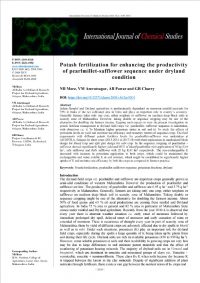Publications
- Potash fertilization for enhancing the productivity of pearlmillet-safflower sequence under dryland condition
- Large-scale demo plot trial project of potash fertilization for increased yield and profitability for smallholder soybean fields in India
- Response in Maize to Applied Potassium: Results from Field Demonstrations in the States of Andhra Pradesh, Chhattisgarh and Maharashtra
- Effect of Potash Fertilization on Potato Yields in States of West Bengal and Jammu & Kashmir
- Fertilizing Indian Rice Plots with Potash
- Assessing the Impact of Balanced Use of Inorganic Fertilizers in Rice-Wheat Cropping System in Bihar
- The Impact of Potassium Fertilization on Sugarcane Yields: A Comprehensive Experiment of Pairwise Demonstration Plots in Uttar Pradesh, India
- Benefits of Potash Fertilization in Rice in Six States of India – Results from Field Demonstrations
- Potash for Life – India, Since 2013
- Nutrition and Health – the Importance of Potassium (in Hindi)
- Potassium – a Nutrient Essential for Life (in Hindi)
- Potassium – the Quality Element in Crop Production (in Hindi)
- Deficiency Poster for Andhra Pradesh
- Tomato brochure for Maharashtra
- Sunflower brochure for Maharashtra
- Sugarcane brochure for Maharashtra
- Soyabean brochure for Maharashtra
- Sorghum brochure for Maharashtra
- Pomegranate brochure for Maharashtra
- Onion brochure for Maharashtra
- Maize brochure for Maharashtra
- Rice brochure for Karnataka
- Potash for Life infographic – results of the first season
- Potash for Life
- Balanced fertilization
- Potash for Life – first season summary
- Apple brochure
- Stone Fruit brochure
- Vegetables brochure
- Sunflower brochure
Potash fertilization for enhancing the productivity of pearlmillet-safflower sequence under dryland condition
This paper shows higher yields of dryland crops (pearlmillet and safflower) with application of potash. The net returns and B:C ratio of pearlmillet–safflower were higher with potash application. This is significant as these field crops are important crops grown in semi-arid conditions of western Maharashtra, but farmers do not apply any potash and yields are very low. These results show the potential of including potash fertilizer for these dryland crops.
This is the output of the IPI project “Potash Fertilizer Management in Dryland Crops of Scarcity Zone of Maharashtra” carried out at Solapur, with the Zonal Agricultural Research Station and under the supervision of PFL project in this region.
Abstract
Indian Rainfed and Dryland agriculture is predominantly dependant on monsoon rainfall accounts for 72% in India of the net cultivated area in India and plays an important role in country’s economy. Generally farmers takes only one crop, either sorghum or safflower on medium deep black soils in scarcity zone of Maharashtra. However, taking double or sequence cropping may be one of the alternative for doubling the farmers income. Keeping such aspects in view the present investigation on potash fertilizer management in dryland field crops viz. pearlmillet-safflower sequence is undertaken, with objectives i.e. i) To Maintain higher potassium status in soil and ii) To study the effects of potassium levels on yield and moisture use efficiency and monetary returns of sequence crops. The field experiments with different potash fertilizer levels for pearlmillet-safflower was undertaken at AICRPDLA, Solapur for three years (2015-2016 to 2017-18) with three replications in randomized block design for kharif crop and split plot design for rabi crop. In the sequence cropping of pearlmillet – safflower showed significantly higher yield and MUE of kharif pearlmillet with application of 50 kg K2O ha-1, rabi safflower and Rabi safflower with 20 kg K2O ha-1 respectively. The non-exchangeable K increased with increase in potassium application to both crops, which could be maintained the exchangeable and water soluble K in soil solution, which might be contributed to significantly higher uptake of K and moisture use efficiency by both the crops as compared to farmers practice.
Keywords: Potash fertilization, pearlmillet-safflower sequence, potassium fractions, dryland





